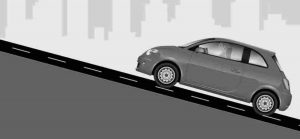 Someone found the blog using the question “can the car roll back at the biting point?” If you understand what the biting point is then you already will know the answer. I’ve explained the biting point before. Here’s a summary.
Someone found the blog using the question “can the car roll back at the biting point?” If you understand what the biting point is then you already will know the answer. I’ve explained the biting point before. Here’s a summary.
If the car is in gear, the clutch acts like a volume control on a radio or mp3 player. When you push the pedal all the way down, the ‘volume’ is at 0, when you lift the clutch all the way up the ‘volume’ is at 10 (maximum). If the clutch is only part way up then the ‘volume’ is somewhere in between.
The “volume” in the case of the clutch is how much of the engine’s power is transferred to the wheels.
In reality, because of how the clutch is designed, the “volumes” we’re interested in occur over a very narrow range of pedal movement quite a way up from fully depressed – this is what we call the biting point. It is not a fixed point, but a range – how much bite depends on what you are trying to do, and where.
A ‘volume’ of 4 or 5 might get the car moving on the flat or perhaps a very gentle incline, but on a steeper upwards slope you might need a setting of 6 or 7 to avoid the car rolling back slightly. Similar considerations apply to moving off more quickly.
Precisely where the bite point occurs in the pedal travel depends on the car. It will be different in every car you drive. Even your own car will change its biting point as time goes by, as the clutch plates wear down. Knowing the basic principle is useful, but operating the clutch and finding the bite should be instinctive rather than coldly calculated every time you need to do it.
So yes, you can roll back at the biting point – if you haven’t got enough bite set.
Will the car roll back when you have the biting point?
By definition, no. However, if you haven’t got enough bite then it might – just as too much bite will make it move forward.
You have to try to understand what the biting point is – and how it is part way between no engine control of the wheels at all and total engine control of the wheels. The exact point of bite varies depending on the angle of incline.
Will I fail my test if I roll back?
It’s not automatic, but if you roll back a lot, or do it every time, then yes you could fail your test for it. I’ve written about it in detail in this article.
EDIT 20/2/2011: I’m still getting hits on questions like “how to find the biting point every time”.
Obviously, I can’t be certain what people are thinking, but the wording (and the fact there is clearly a problem) suggests people are perhaps being a little lazy in the way they approach driving.
You cannot just magically “find” the biting point at the outset unless you think hard about it. You have to “feel”, “look”, and “listen” for it (i.e. feel the car change its revs, listen for the engine slow down, and look for the slight movement as the bite takes). The more you do it then the quicker you’ll get to that magic point where you just find it and go without having to think.
Some people – not many in my own experience – have a serious coordination problem and find manual driving a huge challenge. If they switch to automatic then they never look back (although if you pass in an automatic you can’t drive manual without passing a test in a manual car). But these are exceptional cases.
Driving properly and safely requires thought. Learning requires even more.